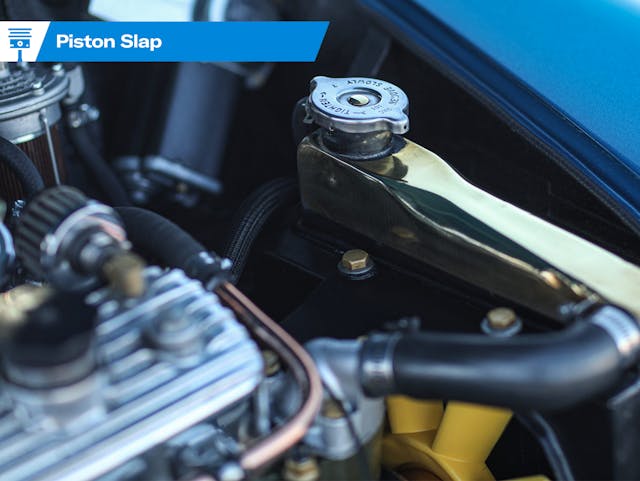Piston Slap: Thoughts on custom cooling for custom vehicles?

Mickey writes:
I would appreciate your comments on dealing with engine cooling on non-factory built vehicles. Issues like grill openings, double core radiators, timing, additives, type of water pump, or other remedies. I have a couple of vehicles that I have struggled with cooling issues in the past, both running Chevy 350 small-blocks. I solved the running hot issue on the Kellison when I discovered it had a high speed racing water pump and changed to a standard factory original pump. My Jeep CJ7 still has some issues.
Sajeev answers:
Fantastic question! Everything you mentioned does indeed affect a cooling system’s performance, and let’s also include cooling fans/multiple fans/pusher and puller fans and the temperature rating of a thermostat. Since we’re talking about street vehicles here, let’s keep that in mind as we address these parts from highest to lowest priority. (The priority is based on its impact, ease of replacement/adjustment, cost, etc.)
- Engine timing: The more ignition advance/retard given from the stock/baseline timing curve, the more likely the engine can overheat. Depending on the engine and cooling system modifications in play, returning timing to stock (or whatever others have done) is a good start, but removing advance/retard incrementally might address the overheating issue without robbing too much power from your setup.
- Thermostat: Installing a colder-than-stock thermostat can help, as introduces coolant into the radiator sooner than a stock thermostat. But be careful of the temperature for fuel injected applications, as colder thermostats can keep the computer from running in closed loop, which hurts all aspects of engine performance. This is a cheap and easy part to replace, and that’s why it’s ranked so high on the list.
- Fan shrouding: if a fan doesn’t have a shroud to route air to or from the radiator, you lose a significantly amount of cooling efficiency. Put a shroud that goes around the fan and over the radiator: if one doesn’t exist for your application, you’ll have to get one fabricated (or 3D printed?).
- Cooling fans: Mechanical fan clutches work well for many applications, and upgrading to a heavier duty clutch could be all you need to improve cooling (i.e. Fox Body Mustang owners often used F-150 truck clutches as an upgrade). But when it comes to improved performance and more power, removing a mechanical fan for an electric fan is generally considered ideal. Fans come in a wide variety of flow rates (in cubic feet per minute) and can either push air into the radiator, or pull it out. For most street vehicles running a conservatively tuned small-block Chevy, you can generally get away with a single puller fan in the correct CFM.
- Radiator: If this is an older part in unknown condition, perhaps make this #1 on the list. Crossflow radiators are generally considered more efficient compared to downflow radiators, and a good rule of thumb is to get the biggest radiator possible for your application. If a custom-engineered solution from the aftermarket is available for your vehicle, that might be your best choice, as they normally make the best use of the space available.
- Water pumps: For street vehicles, your experiences with water pumps mirror that of mine. A factory-style pump is gonna be more than adequate, but consider switching to an electric pump if you want to squeeze a little more horsepower at the same time.
- Grille/hood openings: While especially important when upgrading to forced induction (especially turbochargers), it is possible that vehicles designed for high speed aerodynamics lack the necessary cooling for a custom engine. Aftermarket bumper covers may be available, but sometimes all you need is a large hood vent to route hot air (from the fan) out of the engine compartment as quickly as possible.
- Cooling additives: I haven’t seen a tangible benefit to a street vehicle with these chemicals. I consider this to be a measure of last resort, after addressing everything else in the cooling system.
- Transmission coolers: If the vehicle has an automatic transmission, running a separate trans cooler in series with the radiator helps both engine coolant and transmission fluid cool more efficiently. Without a standalone trans cooler, the engine coolant is tasked with removing heat from the transmission fluid in the same radiator. Double cooling is a far better idea, and adding a small electric fan to the transmission cooler is a great idea for applications with poor airflow.
For your Jeep, I would look into options 1–4, and 8 if applicable. No matter, this is a good general guide to addressing cooling system upgrades to match an upgraded engine. Hopefully I didn’t miss something. Did I miss something? This is your cue to join the conversation below, Hagerty Community.
Have a question you’d like answered on Piston Slap? Send your queries to pistonslap@hagerty.com, give us as much detail as possible so we can help! If you need an expedited resolution, make a post on the Hagerty Community!

